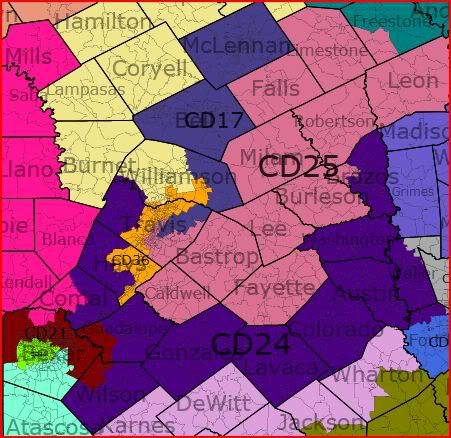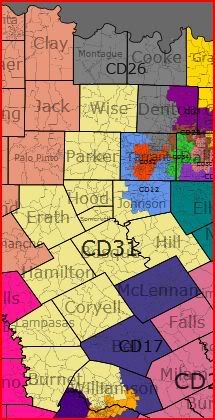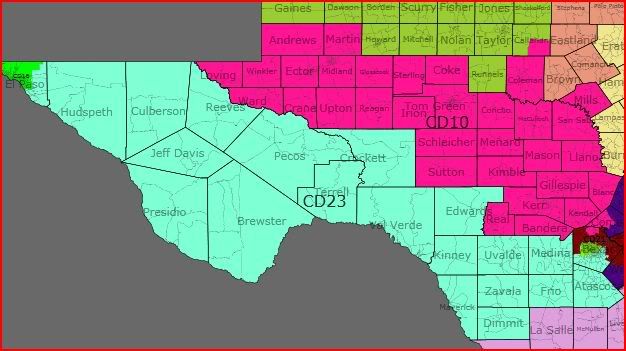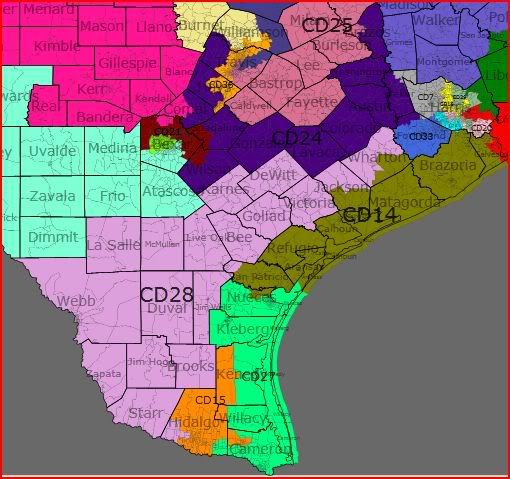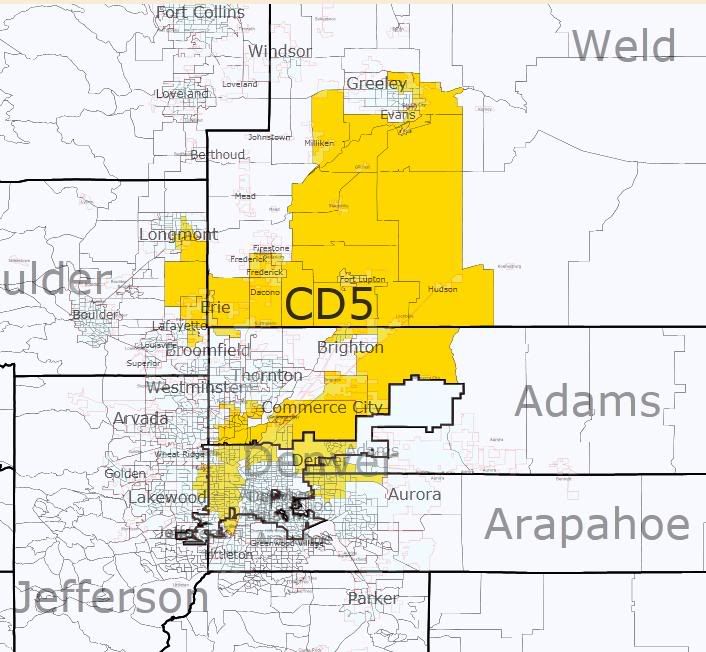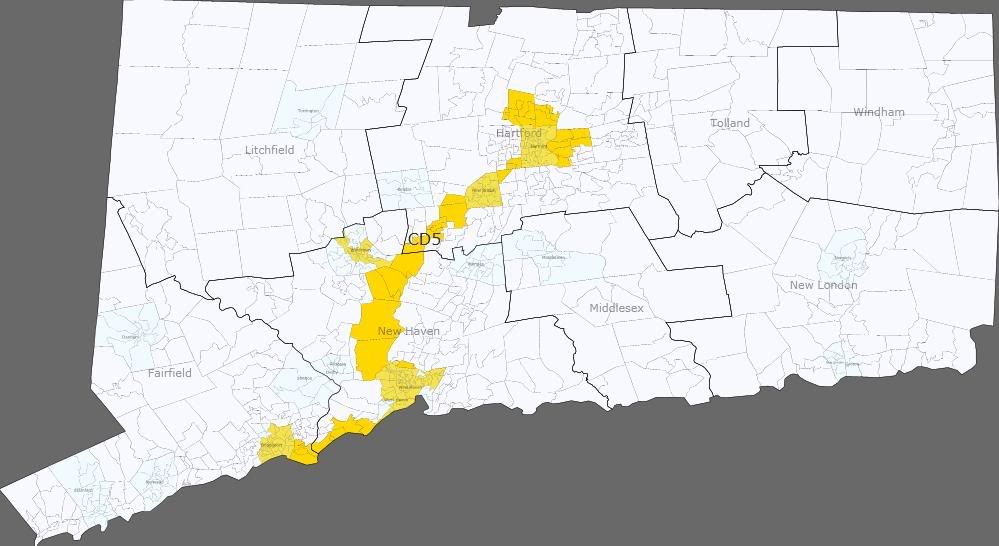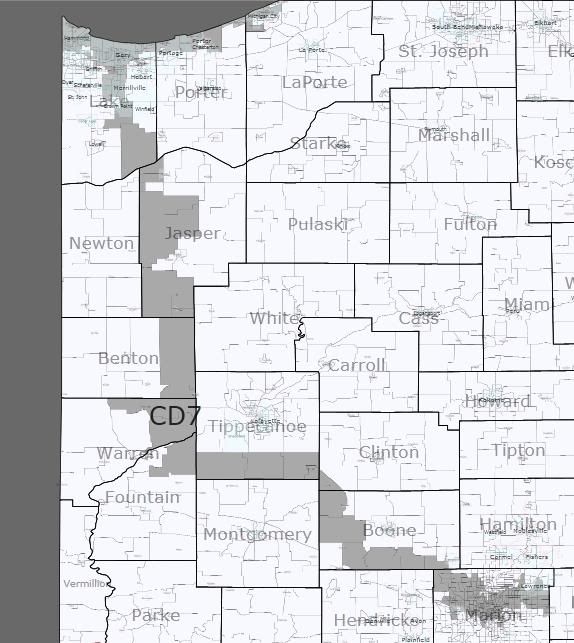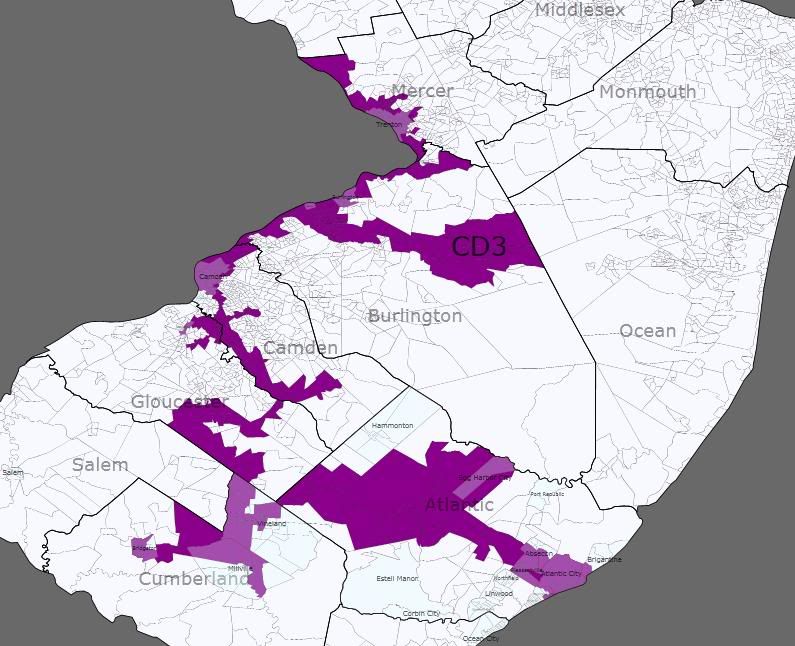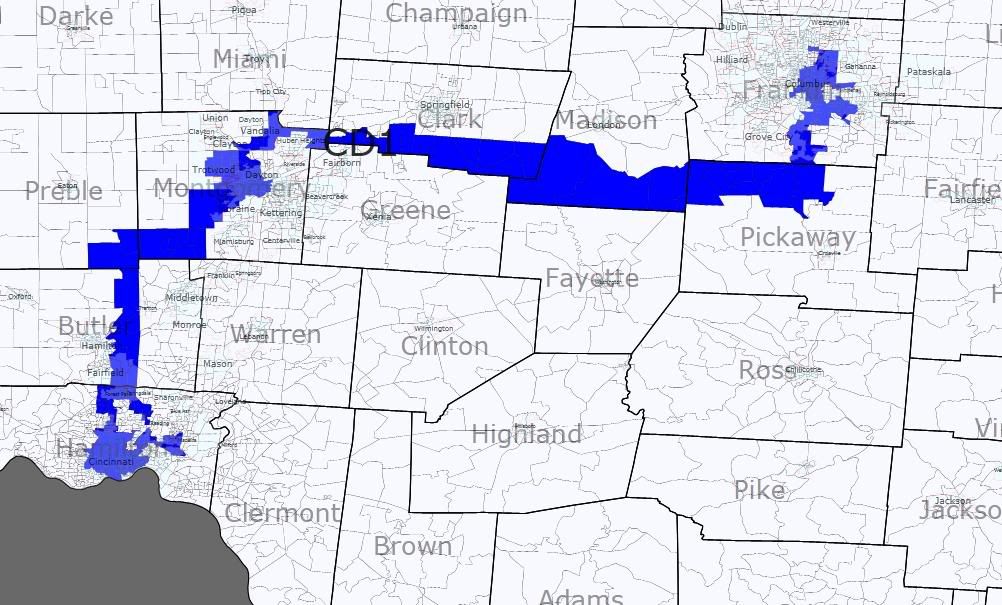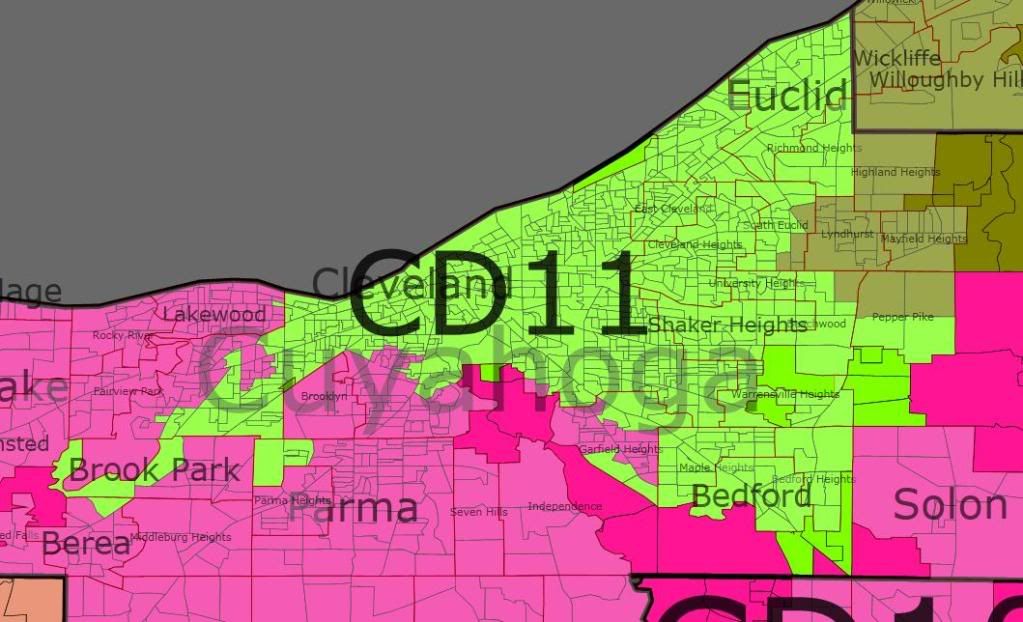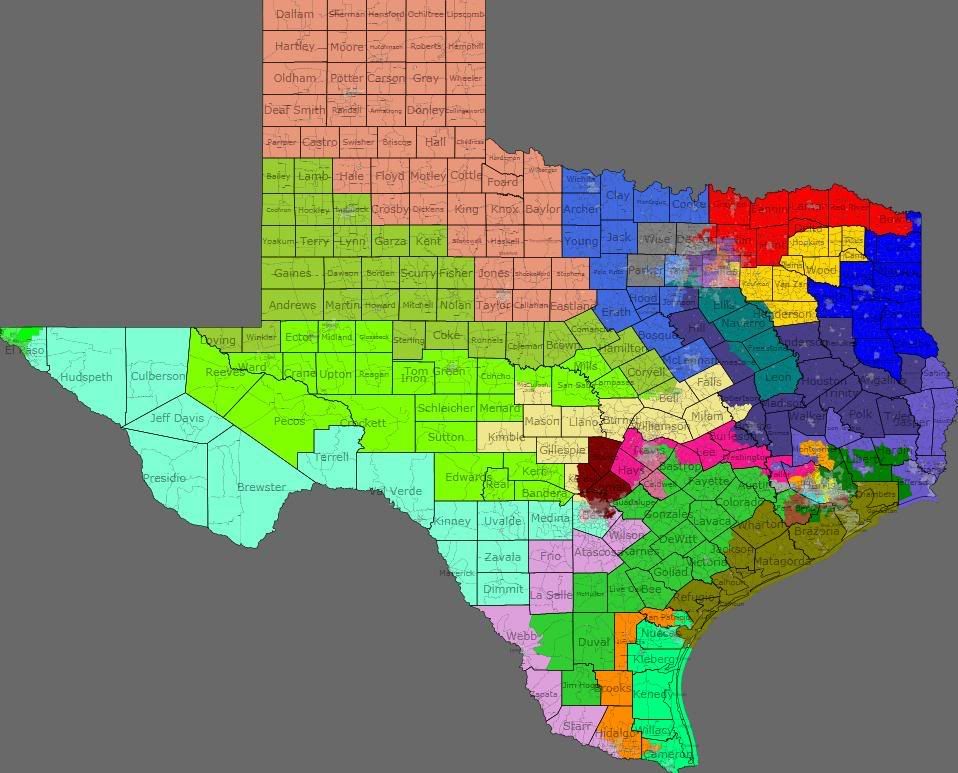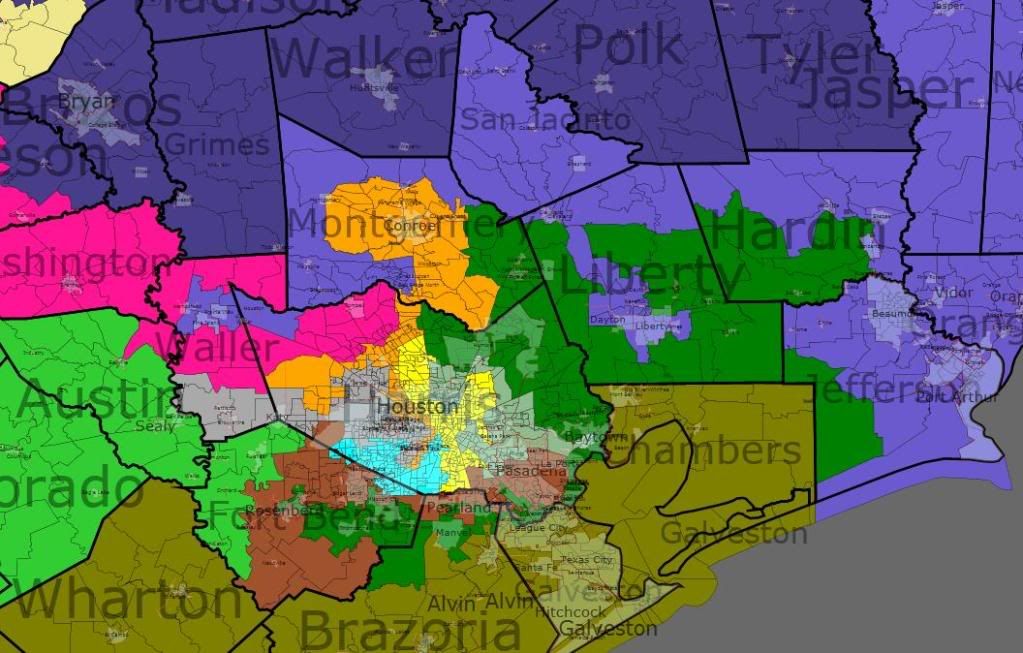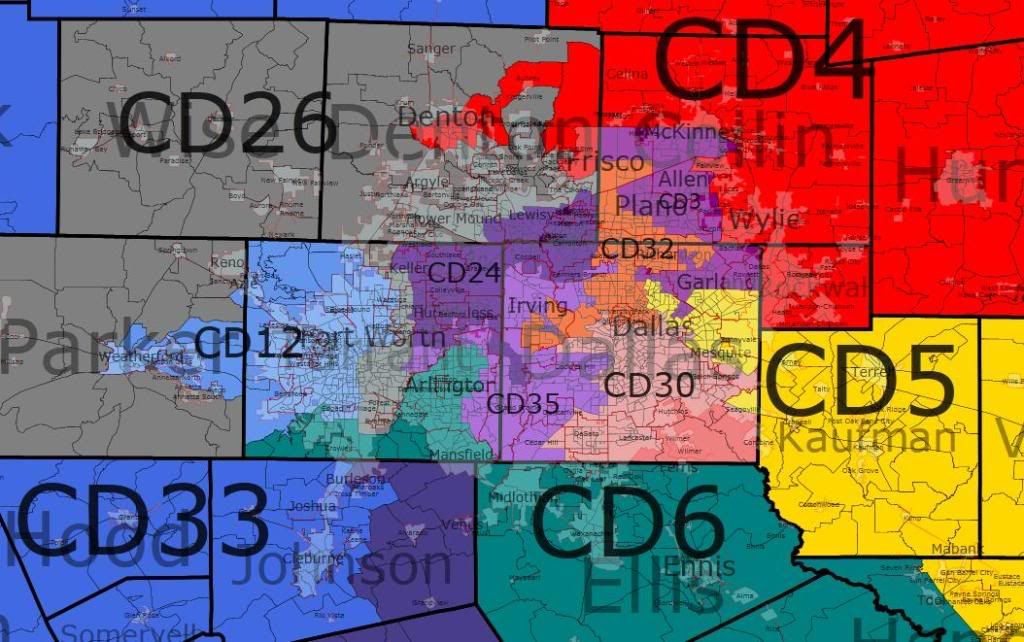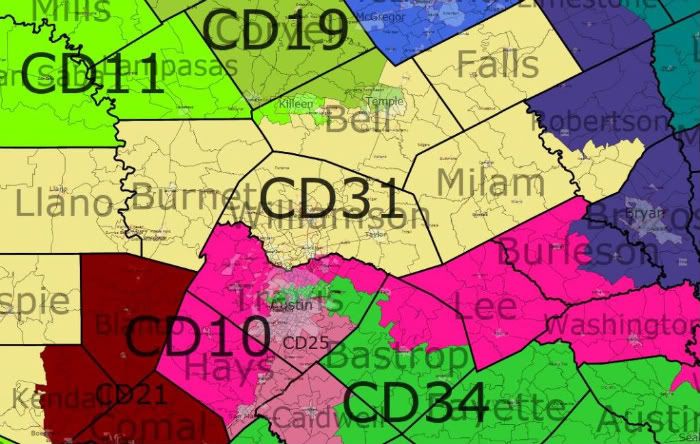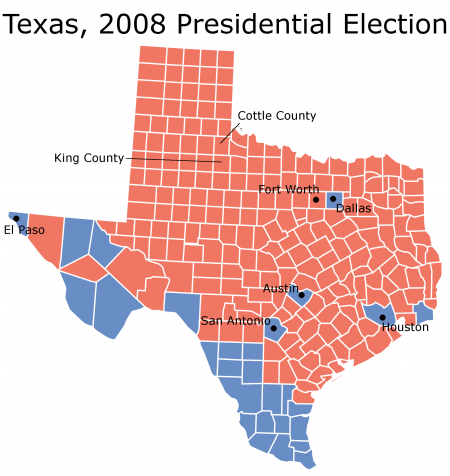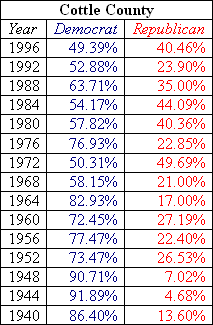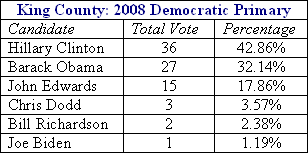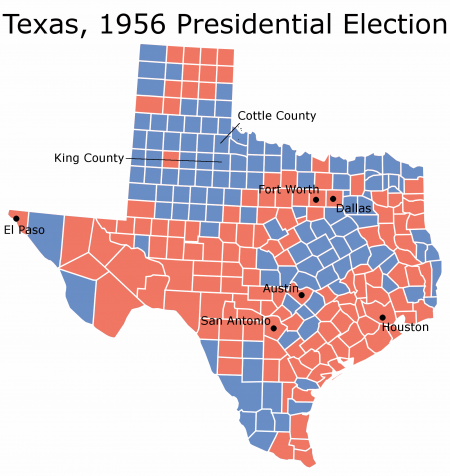I know that the Dems controlling the trifecta in Texas is about as likely as the Detroit Lions winning the next Super Bowl, but I decided to give a Democratic gerrymander a shot anyways. Without further ado, here it is
District 1 (Blue): Louie Gohmert, a real nutjob’s nutjob, is safe as can be in this district, which is shifted north somewhat, but is still based in the congressman’s hometown of Tyler.
Incumbent: Louie Gohmert
Voting: 30% Obama, 70% McCain
Demographics: 72% White, 19% Black, 7% Hispanic
District 2 (Green): Ted Poe will be spending a lot less time in the suburbs, as this is now an East Texas district, although it still includes his home in Humble, which is located in Harris County.
Incumbent: Ted Poe
Voting: 29% Obama, 70% McCain
Demographics: 77% White, 12% Black, 9% Hispanic
District 5 (Yellow): Jeb Hensarling, much like Ted Poe, suddenly finds that most of his constituents are now East Texans. Much of this new territory is currently represented by Ralph Hall, who becomes a man without a district. However, Hensarling’s home is included in the tendril that reaches into Dallas County
Incumbent: Jeb Hensarling
Voting: 33% Obama, 66% McCain
Demographics: 78% White, 10% Hispanic, 8% Black 5% Asian
District 6 (Teal): Joe Barton gets a cozy Republican vote sink, albeit with a small problem named Ralph Hall, since Rockwall County has been added to the district. Hall, being as old as he is, will probably opt to retire rather than be demolished by Barton in the primary.
Incumbents: Joe Barton, Ralph Hall
Voting: 28% Obama, 71% McCain
Demographics: 77% White, 12% Hispanic, 10% Black
District 8 (Periwinkle): Kevin Brady gets an overwhelmingly Republican district based in Montgomery County (Conroe). While most of the district’s population is in Montgomery County, it includes some other heavily Republican rural counties.
Incumbent: Kevin Brady
Voting: 26% Obama, 73% McCain
Demographics: 77% White, 12% Hispanic, 9% Black
District 4 (Red): This district isn’t quite as East Texas-y as the rest of the districts in this category, but it’s based in Beaumont, so I included it here anyways. It’s an open seat that stretches from Beaumont to Harris County, where it picks up some heavily Democratic neighborhoods. It’s drawn to elect a Democrat, and possibly a member of a minority group. If Nick Lampson still has any desire to be a Congressman, this would be the place for him to run.
Incumbent: OPEN SEAT
Voting: 54% Obama, 46% McCain
Demographics: 42% White, 32% Hispanic, 23% Black
District 29 (Weird Grayish Green): Gene Green’s district is still heavily Hispanic and Democratic. Gene Green is safe here.
Incumbent: Gene Green
Voting: 60% Obama, 39% McCain
Demographics: 55% Hispanic, 27% White, 15% Black
District 18 (Yellow): Sheila Jackson Lee’s district now has a slight Hispanic plurality, and sees a drop in Democratic performance, although Obama still won this district in a landslide. The edge Hispanics have over Blacks in the district is small enough that a successful racial primary challenge is unlikely.
Incumbent: Sheila Jackson Lee
Voting: 64% Obama, 35% McCain
Demographics: 33% Hispanic, 31% Black, 30% White, 5% Asian
District 20 (Light Pink): This is an open seat that leans Republican. Its creation was necessitated by the screwing over of Pete Olson. In spite of this fact, it has no overlap with Olson’s current district. However, if 2012 is a good year, it’s possible we could contest this.
Incumbent: OPEN SEAT
Voting: 44% Obama, 55% McCain
Demographics: 63% White, 21% Hispanic, 9% Black, 7% Asian
District 9 (Light Blue): This is a plurality-black district represented by Al Green. Like the 18th district, this district sees a sharp drop in Democratic performance. However, Obama won here in a landslide
Incumbent: Al Green
Voting: 64% Obama, 35% McCain
Demographics: 32% Black, 30% White, 28% Hispanic, 9% Asian
District 7 (Gray): Wanna know how I can get all these Democratic districts out of a county that gave Obama 50.5% of the vote? By making sure Republican votes are wasted in districts like this one, which is represented by John Culberson.
Incumbent: John Culberson
Voting: 34% Obama, 66% McCain
Demographics: 69% White, 17% Hispanic, 7% Asian, 6% Black
District 33 (Medium Blue): Now we get to the fun part; setting Republican incumbents up for defeat. Enjoy it, because you won’t see any more of this until we get to Dallas. This is a new, Democratic district based in Fort Bend County. It also includes some minority-heavy areas currently represented by Al Green. Under these lines, Pete Olson’s second term will probably be his last.
Incumbent: Pete Olson
Voting: 55% Obama, 45% McCain
Demographics: 40% White, 23% Hispanic, 22% Black, 14% Asian
District 17 (Bluish Purple): My number one priority while making this map was protecting Chet Edwards. Out of all 435 members of the House, he is probably my favorite, which is something I never thought I’d say about a Texan. (Seriously, learn to drive in the snow before you come to Colorado in the winter). This district includes his current base of Waco, his pre-DeLaymander base of Bell County, and some minority heavy areas of Travis County where Obama won a staggering 83% of the vote, enough for Obama to carry this district by about 1,000 votes. Edwards is untouchable here, and this district will be a tossup at worst when he retires.
Incumbent: Chet Edwards
Voting: 50% Obama, 49% McCain
Demographics: 54% White, 22% Hispanic, 20% Black
District 25 (Salmon): This district looks like a sprawling, rural slice of Central Texas where a liberal Democrat like Lloyd Doggett wouldn’t stand a snowball’s chance in hell. However, looks can be deceiving. While Austin accounts for only a tiny fraction of the land area, it consists of most of the district’s population, and its liberal voting habits are more than enough to make this a safe Democratic seat.
Incumbent: Lloyd Doggett
Voting: 58% Obama, 40% McCain
Demographics: 56% White, 30% Hispanic, 10% Black
District 36 (Orangeish): This district runs from southern Williamson County to San Marcos, passing through Austin along the way, which is where it gets most of its population. It is an open seat, with a strong Democratic lean.
Incumbent: OPEN SEAT
Voting: 56% Obama, 43% McCain
Demographics: 67% White, 20% Hispanic, 7% Black, 6% Asian
District 24 (Purple): The vote sink where most of the region’s Republicans, along with Congressman Mike McCaul, end up living. While I could have targeted the perpetually shaky McCaul for defeat, I chose to create a new open seat instead.
Incumbent: Mike McCaul
Voting: 33% Obama, 65% McCain
Demographics: 72% White, 18% Hispanic, 7% Black
District 21 (Wine Red): This district, while less Republican than before, would still be an uphill climb for any Dem. It consists of suburban San Antonio, and is represented by Lamar Smith.
Incumbent: Lamar Smith
Voting: 41% Obama, 58% McCain
Demographics: 62% White, 27% Hispanic, 7% Black
District 11 (Radioactive Green): This is a heavily Hispanic district based in San Antonio. It changes very little, but is renumbered (it used to be the 20th).
Incumbent: Charlie Gonzales
Voting: 62% Obama, 36% McCain
Demographics: 67% Hispanic, 24% White, 6% Black
District 31 (Yellowish Tan): This district is made much, much more Republican, largely due to the inclusion of some very hostile territory that is currently represented by Chet Edwards, and the removal of both Bell County and Democratic areas of Williamson County. Obama didn’t even break 30% here, and John Carter is completely safe.
Incumbent: John Carter
Voting: 29% Obama, 70% McCain
Demographics: 82% White, 11% Hispanic, 4% Black
District 26 (Dark Gray): Here’s another Republican vote sink. I really wouldn’t consider this a Central Texas district, as most of its residents live in Denton and Tarrant Counties, but it didn’t fit in the screen shot of Dallas, so it gets lumped in here. It is represented by Michael Burgess, who is an anonymous backbencher. However, it was formerly represented by Dick Armey.
Incumbent: Michael Burgess
Voting: 32% Obama, 67% McCain
Demographics: 82% White, 10% Hispanic, 5% Asian, 4% Black
District 12 (Light Blue): This district is designed to pack Republicans, and connects two separate, heavily Republican sections of Tarrant County via Johnson County.
Incumbent: Kay Granger
Voting: 34% Obama, 65% McCain
Demographics: 76% White, 13% Hispanic, 6% Black
District 35 (Light Purple): This district, which resembles a backward L, is a newly created open seat that is composed of suburbs to the east and south of Dallas. It is contained entirely within Dallas County, and was won handily by Obama.
Incumbent: OPEN SEAT
Voting: 56% Obama, 43% McCain
Demographics: 56% White, 20% Black, 19% Hispanic, 6% Asian
District 30 (Salmon): This is a heavily Democratic, plurality Black district represented by Eddie Bernice Johnson. It meanders about Dallas County, combining minority-heavy Democratic areas with areas to the north of Dallas that are heavily White and Republican, and currently form the base of Pete Sessions, who is unfortunate enough to find his home in this district, although the prospect of him running here is unlikely, as there are several less hostile districts nearby.
Incumbents: Eddie Bernice Johnson, Pete Sessions
Voting: 66% Obama, 33% McCain
Demographics: 34% Black, 32% Hispanic, 31% White
District 34 (Green): This is another open seat which should lean Democratic. It includes a fair bit of territory that is currently represented by Pete Sessions, but I just don’t see a district that’s only 42% White electing a Republican.
Incumbents: OPEN SEAT
Voting: 55% Obama, 44% McCain
Demographics: 42% White, 38% Hispanic, 12% Black, 7% Asian
District 22 (Brown): This is easily the most gerrymandered district in the entire state. It meanders through Tarrant, Denton, Collin, and Dallas counties, picking up swingish areas, and includes a small portion of Central Dallas, which is enough to put Obama over the top here. While Kenny Marchant isn’t a sure loser under these lines, he’ll have a tough fight on his hands hold onto this district, where much of the territory is new to him. Even if he wins in 2012, this district is trending Democratic, and he will never be able to take it for granted.
Incumbent: Kenny Marchant
Voting: 51% Obama, 48% McCain
Demographics: 57% White, 22% Hispanic, 13% Black, 8% Asian
District 3 (Dark Purple): Nothing to see here, folks. This district is heavily Republican and based in Plano. It is represented by Sam Johnson, and even after he retires, as folks his age are bound to do eventually, it will be safe for the Republicans.
Incumbent: Sam Johnson
Voting: 37% Obama, 62% McCain
Demographics: 78% White, 10% Hispanic, 8% Asian, 5% Black
District 32 (Orange): This is a new, Democratic district which encompasses much of Tarrant County. Obama won here handily, and whoever wins the Democratic nomination will be a strong favorite.
Incumbent: OPEN SEAT
Voting: 56% Obama, 43% McCain
Demographics: 48% White, 27% Hispanic, 20% Black
District 13 (Light Pink): It’s unbelievable that this district was represented by a Democrat as late as the 1990s, because now it’s the most Republican district in Texas, and possibly in the entire nation. Obama flirted with the 20% mark here, while McCain scored close to 80%. It’s based in Amarillo, and includes the Texas Panhandle, and expands to take in some conservative areas south of Wichita Falls.
Incumbent: Mac Thornberry
Voting: 22% Obama, 77% McCain
Demographics: 74% White, 18% Hispanic, 5% Black
District 19 (Pea Soup Green): This district, while still stretching from Lubbock to Abilene, takes on a much less gerrymandered appearance, but doesn’t lose any Republican strength. Randy Neugebauer is still a Congressman for life.
Incumbent: Randy Neugebauer
Voting: 28% Obama, 71% McCain
Demographics: 63% White, 29% Hispanic, 6% Black
District 10 (Hot Pink): This Midland-based district exists due to Tom Craddick. It does an excellent job of packing Republicans, so I figured I’d keep it around.
Incumbent: Mike Conaway
Voting: 24% Obama, 75% McCain
Demographics: 67% White, 28% Hispanic, 3% Black
District 16 (Bright Green): This is a heavily Democratic and Hispanic district based in El Paso. It hardly changes at all from its current form.
Incumbent: Silvestre Reyes
Voting: 65% Obama, 34% McCain
Demographics: 76% Hispanic, 18% White, 3% Black
District 23 (Pale Blue): Ciro Rodriguez comes out of redistricting as a big winner. His district goes from one that barely supported Obama over McCain to one that supported Obama with over 60% of the vote. This is because it no longer includes nearly as many Republican areas of Bexar County. Taking the place of those Republican areas are heavily Democratic neighborhoods in San Antonio.
Incumbent: Ciro Rodriguez
Voting: 61% Obama, 38% McCain
Demographics: 72% Hispanic, 21% White, 5% Black
District 28 (Light Purple): This district, which stretches from the border town of Laredo to the exurbs of Houston, adds some Democratic strength. I find the current map, where a couple of the South TX districts, including this one, have Republican PVIs, to be no bueno, and I set about rectifying that situation.
Incumbent: Henry Cuellar
Voting: 55% Obama, 44% McCain
Demographics: 76% Hispanic, 20% White, 3% Black
District 15 (Orange): This district becomes much more compact and Democratic, and is concentrated mostly in Hidalgo County. Ruben Hinojosa has nothing to worry about here.
Incumbent: Ruben Hinojosa
Voting: 66% Obama, 33% McCain
Demographics: 85% Hispanic, 13% White
District 27 (Greenish): This district, which stretches from Corpus Christi to Brownsville is, heavily Hispanic. Like the other Hispanic districts in South Texas, it becomes somewhat more Democratic.
Incumbent: Solomon Ortiz
Voting: 56% Obama, 43% McCain
Demographics: 74% Hispanic, 22% White, 2% Black
District 14 (Greenish Brown): We finish with the district of Ron Paul. The vast majority of this district’s population is in Brazoria County, which is where Paul is from. The district is heavily Republican.
Incumbent: Ron Paul
Voting: 34% Obama, 65% McCain
Demographics: 62% White, 28% Hispanic, 7% Black


